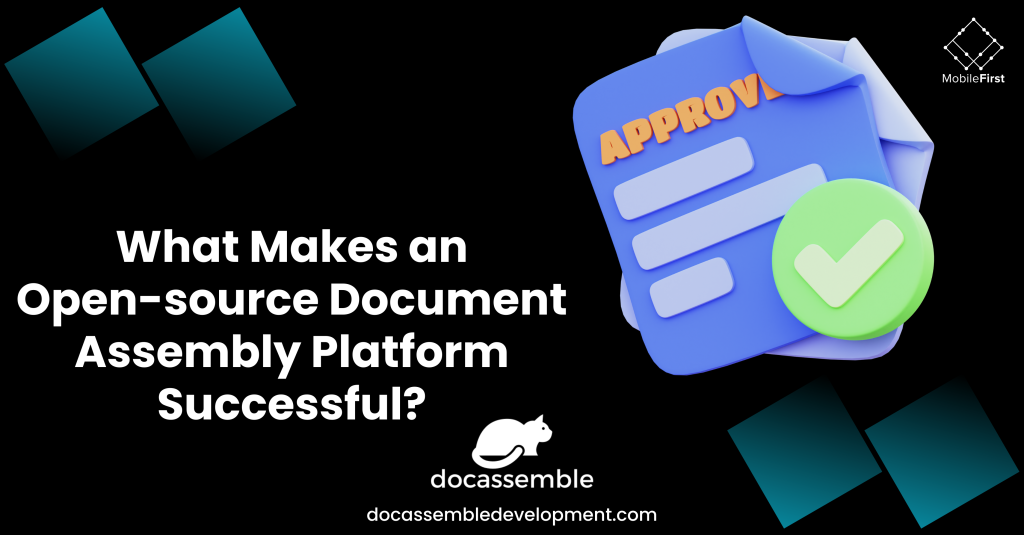
Introduction
Document assembly platforms are software solutions designed to streamline and automate the process of creating complex documents. They play a crucial role in transforming manual document creation into an efficient, automated workflow.
Understanding Document Assembly Platforms
These platforms utilize templates, variables, and logic to generate documents based on predefined rules and data inputs. They often leverage user-friendly interfaces, allowing users to input information without the need for extensive technical expertise.
Key Components
Templates: Predesigned document structures that serve as a foundation.
Variables: Data fields within templates that get populated with user-provided information.
Logic: Rules determining the document’s structure and content based on variable inputs.
Benefit of using Docassemble
Docassemble offer much more advantages than just cutting down on paperwork. Let’s examine these platforms’ revolutionary impact on document creation in more detail by concentrating on five main advantages:
1. Time and Efficiency Savings
Automation Reduces Human Burden: Automating repetitious operations such as clause selection, formatting, and template filling is achieved by document assembly systems. Professionals can now devote more of their valuable time to high-level tasks like customer interaction, evaluation, and negotiation. Can you imagine creating a complicated contract in minutes as opposed to hours?
Tight Deadlines Meet Quick Turnaround: Assembly platforms generate documents more quickly and optimize operations by accelerating data input. You can maintain projects on schedule, meet deadlines without exerting much effort, and respond to urgent demands more quickly.
2. Consistency and Accuracy
Standardization Breeds Order: Document assembly platforms enforce consistent formatting, language, and terminology across all documents, eliminating the risk of inconsistencies that can confuse and frustrate clients or partners. No more hunting for the latest template or worrying about typos!
Error Reduction Minimizes Risk: Manual data entry is prone to errors, typos, and omissions. Assembly platforms automatically populate fields with verified data from trusted sources, significantly reducing the risk of errors that can lead to legal or financial repercussions.
3. Customization and Flexibility
Tailoring Documents for Unique Needs: Document assembly platforms aren’t rigid templates; they’re dynamic tools that allow you to tailor documents to specific situations and individual recipients. Easily add or remove clauses, sections, and even entire documents based on user-defined conditions and logic.
Adaptability Across Industries: Whether you’re in legal, finance, healthcare, or any other field, document assembly platforms can adapt to your needs. Create contracts, financial reports, patient charts, or any other document specific to your industry with ease.
4. Cost-effectiveness
Reduced Overhead, Increased Productivity: There are substantial cost reductions associated with automating repetitive operations and reducing errors. A more effective and productive company will result from staff time being used less for document creation, lower printing and paper costs, and reduced overall time spent on document creation.
Reduced Licensing Expenses Compared to Conventional Approaches: As an alternative to traditional proprietary software, several document assembly systems come with open-source or subscription-based models, which spare users the high upfront expenses. For businesses of all sizes, it’s an affordable option because you only pay for what you use.
5. Coordination and Version Management
Effective Collaboration with Shared Workspaces: Document assembly platforms enable several users to collaborate in real time on a single document, removing version control hassles. Within the platform, you can track changes, exchange ideas, and make sure everyone is in agreement.
Versioning guarantees transparency and traceability since assembly systems keep track of document revisions automatically and make it simple to go back to earlier iterations when necessary. When working together on documents, stay accountable, transparent, and well-organized.
Looking to integrate DocAssamble in your product?

Open Source Efficiency: DocAssemble vs. Traditional Document Assembly Platforms
Document generation, historically a tedious and error-prone slog, has been liberated by the agility and power of open-source platforms like DocAssemble. Traditional closed-source systems often come with crippling limitations:
Costly Burden: Licensing fees and per-user charges can bleed budgets, especially for smaller organizations.
Rigid Templates: Inflexible templates force users to conform, hindering customization and personalized document creation.
Vendor Lock-in: Dependence on a single vendor restricts choice and leaves users vulnerable to price hikes or discontinuation.
DocAssemble flips the script with its open-source approach, empowering users with:
Flexibility: Craft intricate applications with branching logic and conditional clauses to dynamically tailor documents to any scenario.
Complete Control: Own your code and data, unshackling yourself from vendor lock-in and enabling deeper customization.
Collaborative Innovation: The open-source nature fosters community contributions and knowledge sharing, accelerating platform development and support.
Don’t let manual document creation hold you back. Explore the possibilities with DocAssemble
Looking to integrate DocAssamble in your product?
Real-world examples illustrate the transformative power of DocAssemble:
Legal Aid Clinic: Ditching their expensive closed-source platform, a legal aid clinic adopted DocAssemble. They built custom interview forms that dynamically generated personalized legal documents, saving staff time and resources while empowering clients with superior service.
Financial Services Company: Onboarding new clients became a breeze for a financial services company with DocAssemble’s automation capabilities. The platform’s flexibility catered to diverse client profiles and regulatory requirements, streamlining the process and boosting accuracy.
Non-Profit Organization: Grant proposals became a collaborative endeavor with DocAssemble. Team members worked on proposals simultaneously, tracked changes, and ensured consistency across documents, dramatically simplifying the application process.
Beyond these specific cases, DocAssemble offers industry-wide advantages:
Reduced Errors: Rigorous community testing and bug fixes inherent in open-source code significantly minimize errors compared to closed-source systems.
Enhanced Security: The transparency of open-source platforms fosters trust and allows for deeper security audits compared to opaque proprietary systems.
Future-proofed Investments: Continuous community development and code ownership ensure long-term stability and eliminate the risk of platform discontinuation by a single vendor.
Experience the power of streamlined document creation with DocAssemble.
Challenges and Considerations
There is no denying the benefits of open-source platforms such as DocAssemble; yet, navigating this terrain is not without its challenges. Let’s examine some possible obstacles and methods for getting around them:
A. Handling Possible Difficulties
- Steeper Learning Curve: In contrast to user-friendly commercial software, open-source platforms may demand technical expertise for setup, adjustment, and upkeep.
- Limited Support: Some open-source projects may have smaller communities or less easily accessible dedicated support options when compared to platforms that are commercially sponsored.
- Security Concerns: Open-source platforms are thought to be more susceptible to security breaches than closed-source systems, despite the fact that transparency can improve security.
B. Techniques for Reducing Difficulties and Increasing Advantages:
- Make Use of Internet Resources: Make use of documentation, tutorials, and community forums to get troubleshooting tips, best practices, and community member support.
- Make security procedures a priority: To reduce possible vulnerabilities, put strong security measures in place, such as frequent upgrades, access restriction, and data encryption.
- Strategy for Integration: When selecting an open-source platform, carefully consider the compatibility difficulties and the current infrastructure. To fill up any gaps, look into third-party products or integration APIs.
- Participate Actively in the Community: Help the platform evolve and sustain its long-term success by reporting bugs, sharing information, and contributing code to the open-source community.